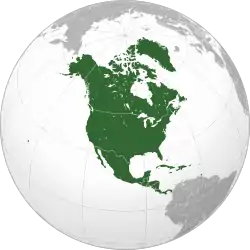Submerged continent
A submerged continent or sunken continent is a region of continental crust, extensive in size but mainly undersea. The terminology is used by some paleogeologists and geographers in reference to some landmasses (none of which is as large as any of the generally recognized continents).

The definition of this term is unclear. If continental fragments and microcontinents smaller than 2,500,000 km2 (970,000 sq mi), which is approx. one third of the area of mainland Australia, are excluded, then Zealandia (approx. 4,900,000 km2 (1,900,000 sq mi)) would be the only geological feature which can be classified as a submerged continent.
Other notable submerged landmasses include Beringia, Doggerland, the Kerguelen Plateau, Mauritia, Sahul, and Sunda.
Submerged continents have been sought and speculated about in regard to a possible "lost continent" underwater in the Atlantic Ocean.[1][2] There was also a search in the 1930s for Lemuria, thought to have been a submerged continent between the Indian and African coasts.[3]
See also
- Continental fragment – Part of a continent broken from its main mass
- List of mythological places – Wikipedia list article
References
- ATLANTIS SEARCH SHIFTS TO AEGEAN; Lost Continent Legend Held Based on False Statistics 1966 New York Times
- "A Submerged Continent". Los Angeles Times. April 4, 1882. Retrieved 2019-05-28.
Ignatius Donnelly has recently published a work in defence of the story that a continent known among the ancients as Atlantis was sunk in the Atlantic Ocean by an earthquake.
- "Submerged continent". The Sydney Morning Herald. November 28, 1932.
.svg.png.webp)
.svg.png.webp)
.svg.png.webp)
.svg.png.webp)


.svg.png.webp)
_political.svg.png.webp)
.svg.png.webp)
.svg.png.webp)
.svg.png.webp)